
Since Windows Virtual Desktop (WVD) launched in 2019, it has rapidly gained popularity among enterprises, government, and educational institutions. Beyond the technological advantages that WVD brings to the table, there are a number of nuances that also make it the most cost-effective cloud-based virtual desktop solution
A core component of the WVD service is the new Windows 10 EVD (Enterprise Virtual Desktop), a multi-session desktop-class Windows operating system. This OS’s (only available in Azure as part of the WVD service) cost advantage comes from the ability to consolidate many individual users onto a single VM, thereby reducing the cost of cloud infrastructure on a per-user basis to a fraction of what it would be in a one-to-one user-to-VM assignment.
Windows 10 EVD is licensed as a subscription that most enterprises already own as part of their existing Microsoft 365 license. Therefore, there is no need to pay anything extra for the RDS license or anything similar. In other clouds, when using multi-session operating systems like Windows Server 2016 and 2019, an RDS license is needed.